How Long Can You Keep Grated Parmesan Cheese in Freezer
There's some leftover parmesan in your fridge, and you don't have a plan of using it anytime soon. That brings the question: can you freeze parmesan cheese?
The good news is, freezing parmesan is perfectly fine, especially if you freeze it grated to later melt it on top of pizza, pasta, or even scrambled eggs.
Whether you have a small wedge, or half a bag of shredded parmesan, freezing is an easy way to prolong the storage time for an extra few months.
But before you chuck all your parmesan in the freezer, you probably want to know if there are any downsides to it. Or if there's anything non-obvious that you should know before you start.
That's what this article is all about. Here, I coverfreezing parmesan blocks and shredded parmesan and discuss how to defrost and use them.
Sounds interesting? Let's jump right in.
Parmigiano-Reggiano is the official name of the original parmesan made in Italy. If your cheese is simply labeled "Parmesan," it may be the authentic Parmigiano-Reggiano or a similar cheese. That's because the term "Parmesan" isn't protected outside the European Union. That said, all the advice below should still apply, no matter if you have the "real" thing or not.
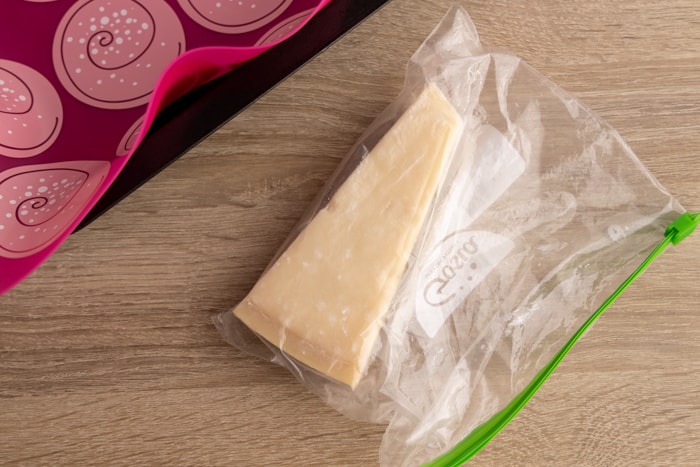
Can You Freeze Parmesan Cheese?
You can freeze parmesan cheese, both in block form and shredded or grated. Both work very well and are viable options for extending the shelf life of leftover parm.
That said, frozen parmesan cheese changes its texture slightly and loses a bit of its signature crumbliness. I didn't notice much of a difference, but many people do, so that's worth pointing out.
In other words, frozen and defrosted parm works best if you grate it and melt it. And you can do that by either freezing it grated or freezing it in a wedge form and grating later on.
One last thing before we proceed.
The shelf life of parmesan is usually pretty long, like a couple of months, so if your wedge or bag are still unopened, check the date on the label before you freeze it. You might still have quite some time left.
That's the rundown on freezing parmesan. Now, let's get into details.
Parmesan cheese freezes very well mainly because of its low water content. The same applies to other low moisture cheeses, such as grana padano.

Can You Freeze Grated Parmesan?
Freezing shredded parmesan works perfectly fine and makes this popular cheese very convenient to use without losing much in terms of quality.
Moreover, if you go with this option, you get a bag of grated or shredded parmesan you can readily use whenever you need some. It's as simple as opening the freezer, scooping as much as you need, and returning the rest.
Grated parm can sit in the freezer for at least a couple of months, which makes it perfect for those of you who love the cheese, but don't use it that often.
Last but not least, you can freeze both store-bought grated parmesan cheese and one that you grate or shred yourself. They both yield great results.
Parmesan rind, which is edible, is quite tough to shred or grate but freezes and melts on top of food just fine. Freezing it grated is a great option.
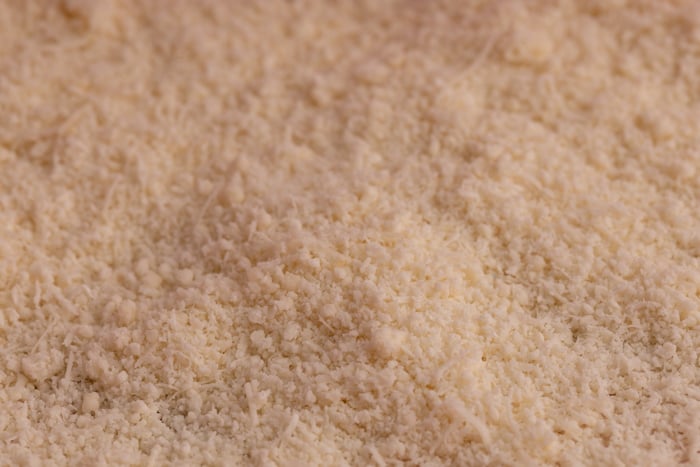
Can You Freeze Parmesan Blocks?
Freezing parmesan blocks is okay, but not ideal. There's a subtle change after you freeze and defrost a wedge of parm: its texture slightly alters, and it loses some of its crumbliness.
The difference in the ability to crumble the cheese isn't huge, but it's there.
If you're like me and just want to add some crumbles as a side for dinner, it's not a big deal – the cheese still crumbles fine (see photos below). I didn't notice any difference when it comes to taste, but I'm far from a parmesan connoisseur.
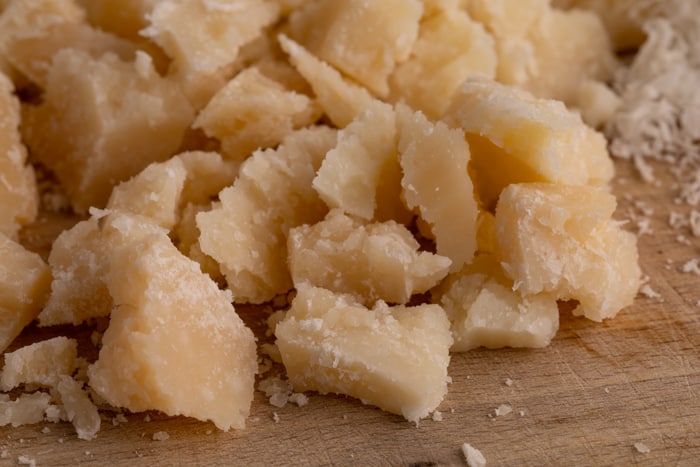
That said, I read in many places that people notice a difference, both in crumbliness and flavor. And because of that, the safest course of action is to stick to using frozen parmesan blocks in dishes where you melt the cheese.
The degree to which your parmesan loses crumbliness depends on how long it sits in the freezer (the longer it's frozen, the worse the change) and whether it's genuine Parmigiano-Reggiano or just a similar cheese.
Of course, even if you freeze a block of parmesan, you can still grate or shred it after thawing. Both options work just fine and give good results. I talk about those more in the section on defrosting parm.
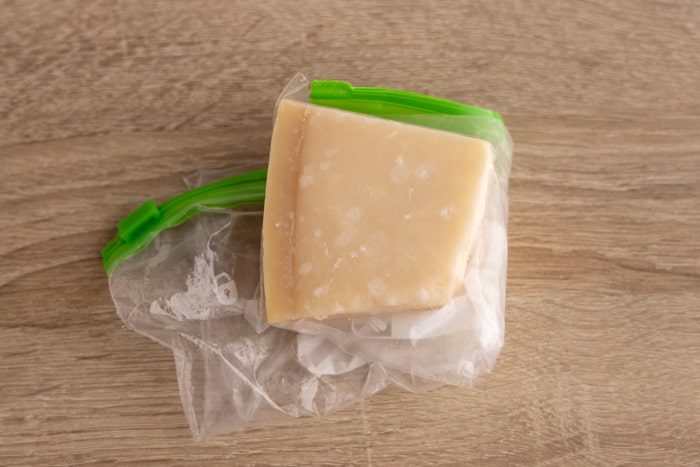
What the Sellers Say
What's interesting is that sellers and authorities on the topic often argue against freezing parmesan. The argument is that the texture changes, and the cheese loses its crumbliness.
Obviously, the crumbliness point only makes sense for parmesan blocks. Once you grate or shred it, that quality is gone, so there's nothing to lose.
Others simply suggest that you should only freeze grated parmesan cheese, and that (to me) rings much closer to the truth.
Long story short, stick to freezing grated Parmigiano-Reggiano and using it for melting to get the best possible flavor.

How To Freeze Parmesan Cheese
You already know the pros and cons of freezing parmesan in block form or grated. Now it's time to discuss how to go about either.
Freezing Parmesan Blocks
Here's the easiest way to freeze parmesan blocks:
- Wrap parmesan tightly. A freezer bag should be good enough for short-term freezing, like a month or so. If you know your parm will sit in the freezer for longer, consider wrapping it with aluminum foil or freezer wrap before you place it in that bag. Remove air before sealing the bag.
- Chuck the parmesan in the freezer. Label it with a name and date if you like.
That's it. It couldn't be any simpler.
If you're lazy or super busy, this method is perfect for you because it takes like 30 seconds or so.
If your parmesan block is wrapped in plastic and still unopened, there's no need to open it up and rewrap it. Just place it in the freezer as-is.
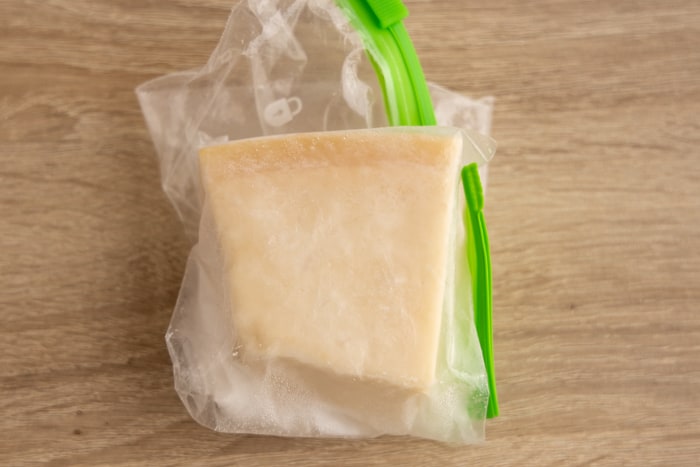
Freezing Grated (or Shredded) Parmesan
Here's how to freeze grated (or shredded) parmesan:
- Grate the parm. Grab a grater and choose whichever side works best for your needs. If your parmesan is shredded already, that's done for you.
- Grab a cookie sheet and spread the grated cheese evenly on it. Feel free to line up the sheet with a silicone mat (my favorite) or anything else that will reduce the cheese sticking to the surface.
- Pre-freeze the cheese. Put the cookie sheet in the freezer and leave it there until the cheese strands freeze solid. It usually takes between 2 to 4 hours. You can also leave it in the freezer overnight.
- Stir it. Take the cookie sheet out of the freezer. You should notice that the cheese is quite sticky. To fix that, grab a spatula (or a fork, or anything else), and give the whole thing a good stir. Your goal is to remove any clumps so that you can easily scoop as much as you need (photos below). That shouldn't take longer than 30 seconds to maybe a minute.
- Transfer the cheese into a freezer bag or airtight container. Now the cheese is ready to be frozen for the long term. If you don't have much room in the freezer, go with a bag. Label it with a name and date if you like.
As you can tell, the process isn't labor-intensive, but you can't do everything in one go. That's probably its only downside.
When it comes to removing the clumps, I'm talking about going from this (where it's all kind of sticky):
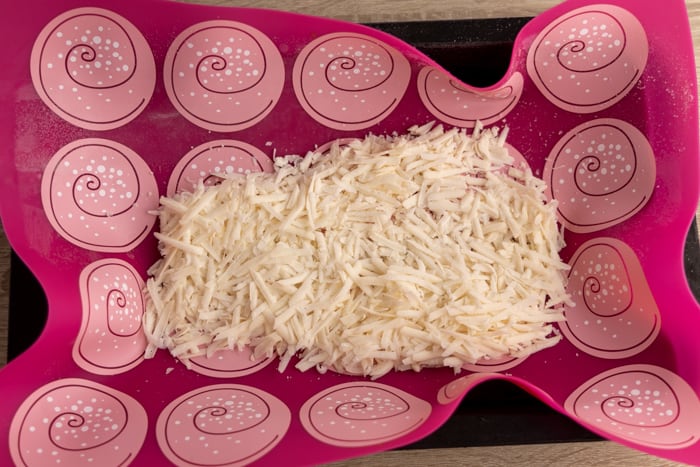
To this (where the cheese is scoopable):

You can skip this step, but it's going to make it more difficult to scoop the amount of cheese you need when needed. I prefer to have the grated cheese nice and ready.
You can also use an anticaking agent to prevent the cheese from sticking together. I talk about if and when you should do this in my article on freezing shredded cheese.
How Long Can You Freeze Parmesan Cheese?
Try to use frozen parmesan cheese within about 3 months to get the best quality. Of course, there's nothing special about this 3-month-period – it's only a rough estimate.
Generally, the longer the parm sits in the freezer, the worse its quality will be. But it's not that it's going to taste great when it's frozen for two months and somehow turn terrible after another two months. Those differences are going to be, in most cases, minute.
In other words, your parmesan that's frozen for more than half a year should still be quite alright flavor-wise.

Every food that sits in the freezer slowly deteriorates, and parmesan isn't an exception. Some of them (like meat) withstand cold temperatures well. Others, like dairy products such as string cheese or mozzarella, not as good.
There's one more thing.
I always recommend eating frozen food as soon as possible. Besides the quality aspect, the issue is that we humans are forgetful.
Unless that parmesan is in your face whenever you open your freezer, you're likely going to forget about it after two weeks, maybe a month. And that's how you end up with food that sits in the freezer for three years.

How To Defrost And Use Parmesan Cheese
Parmesan Blocks
There are at least two ways you can go about using frozen parmesan blocks or wedges. Here they are, along with the pros and cons.
Grate it frozen
You can still grate or shred a frozen parmesan wedge. The cheese is firmer when frozen, but the difference isn't that big. Just a bit more elbow grease is needed.
This option is great if you won't use the whole frozen block in one go. You just take the wedge from the freezer, grate as much as you need, and return the rest.
And now you have grated frozen parm on hand, about which I talk in detail in the next section.

Defrost the wedge
A parmesan wedge needs between 2 to 8 hours in the fridge to defrost. Unless it's a giant one, which might need 16 hours or even more.
The easiest way to defrost it is to leave it in the refrigerator overnight.
Once it's thawed, you can grate, shred, or crumble it, depending on what you need. And in most cases, nobody will be able to tell if that parm was frozen or not.
Just keep in mind that the quality of crumbled defrosted parmesan might be a bit worse than this of a fresh wedge. In other words, if you have any cheese connoisseurs coming for dinner, and you're setting up a cheese platter, stick to fresh parm.
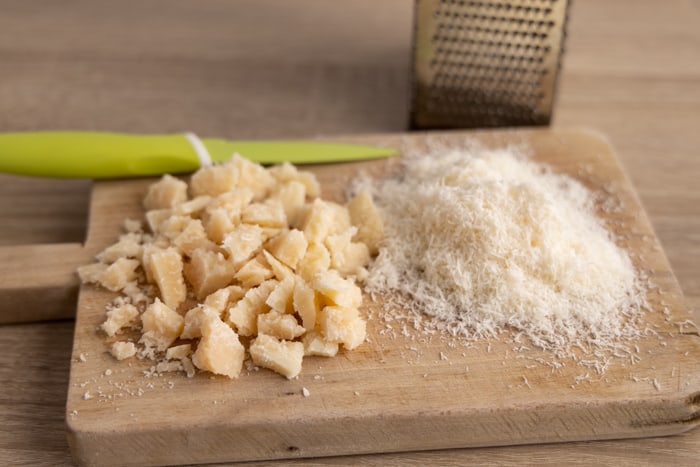
Shredded (or Grated) Parmesan
Without defrosting
The easiest way to use frozen grated parmesan is to skip defrosting and just add it frozen to whatever dish you're cooking.
That works exceptionally well if that dish is still being cooked (or is about to be) because you only need an extra minute or two of cooking for the parm to melt.
Unfortunately, it doesn't work as well if that dish is already cooked and you're only sprinkling it with shredded parmesan after plating (like you do with some pasta dishes).
Frozen parmesan needs more heat to defrost and warm up than refrigerated parm. Because of that, you're likely going to end up with half-melted parmesan or a lukewarm dish. Neither is ideal.

With defrosting
Another way to go about it is to defrost the shredded parmesan cheese before using it. All it needs is a few hours in the fridge, or you can leave it there overnight.
Once it's defrosted, you use it exactly the same way you use freshly shredded parmesan. And it gets you similar results.
The only downside is that if you're using parm that you grated or shredded yourself, it might be a bit more sticky than usual after you defrost it. That's not the case for store-bought grated parmesan, though, because it usually contains some sort of anti-caking agent (like potato starch) to prevent that.
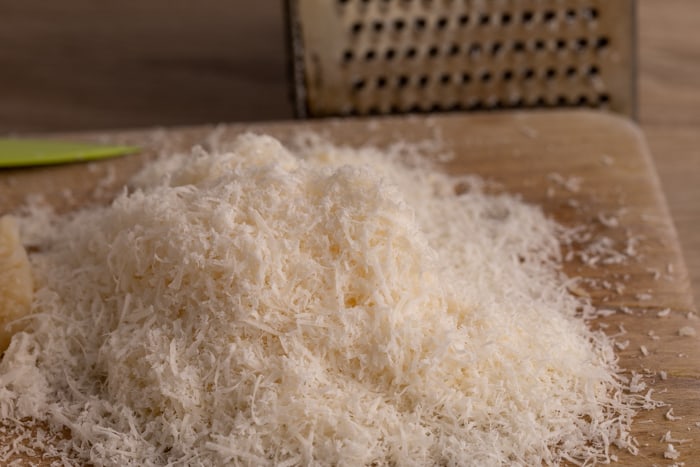
Verdict
For me, freezing shredded or grated parmesan is the way to go. It makes it super easy to use without any extra steps, so I don't need to muster any willpower to do so.
Besides, all dishes with parmesan that I make involve melting the cheese, so it's super convenient just to pop open the freezer, scoop some grated cheese, and return the bag or container.
You can even freeze a big batch that's enough for a couple of months if you're big on parm.
But if your repertoire of dishes includes some in which you melt the parm and others that involve crumbling it, go with freezing it whole. You can always grate a bit if needed, even without defrosting the rest.
In other words, if you want more options, freezing parmesan blocks is your best bet. Just remember that a defrosted wedge might not be as crumbly as a fresh one.
How Long Can You Keep Grated Parmesan Cheese in Freezer
Source: https://www.canyoufreezethis.com/can-you-freeze-parmesan-cheese/